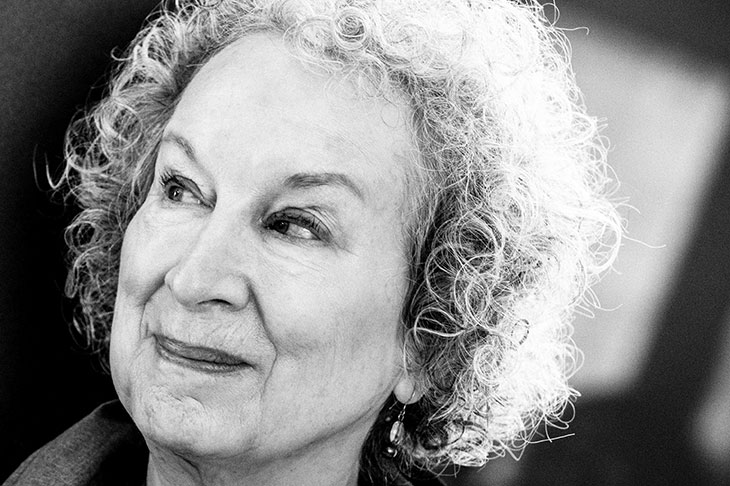‘Penises,’ Aunt Lydia muses, ‘them again.’ Penises are always causing trouble, even in the God-fearing dystopian state of Gilead. The Testaments is set 15 years after the end of The Handmaid’s Tale, at a time when young girls, carefully and modestly brought up to become wives to the regime’s male elite, are beginning to rebel; some would rather die than get married and there has been an attempted suicide via secateurs in the flower-arranging class. ‘Perhaps we need to change our educational curriculum,’ Aunt Lydia thinks, ‘less fear-mongering, fewer centaur-like ravishers and male genitalia bursting into flame. But if we were to put too much emphasis on the theoretical delights of sex, the result would almost certainly be curiosity and experimentation, followed by moral degeneracy and public stonings.’
Aunt Lydia wonders if the disturbed pupil might be schooled to view a penis as a means to an end, a prelude to having a baby? Or brainwashed out of her aversion through sleep deprivation and 20-hour prayer sessions? But no, the terrified girl believes she has ‘a calling to higher service’: she wants to become one of the celibate nun-like Aunts, she wants the privilege withheld from all other girls in the Republic of Gilead, the privilege of learning to read and write.
Aunt Lydia is approximately as old as Margaret Atwood, who was born in 1939. She remembers the founding of Gilead in New England, the suspension of the US Constitution, the liquidation of Congress, the mass executions and the terror. Before the coup, she was a distinguished family court judge who had an abortion to prioritize her career, ‘a law degree and a uterus: a lethal combination’. After Gilead was established to address the problem of the US’s declining birth rate, she was tortured, then recruited as a trusted enforcer of the new rules for girls and women. She writes her testament at Ardua Hall in the Hildegard Library, surrounded by forbidden texts from the old world: Anna Karenina, Tess of the d’Urbervilles, Paradise Lost, Lives of Girls and Women. She hides her manuscript inside a hollowed-out copy of Cardinal Newman’s X-rated (because Roman Catholic), Apologia Pro Vita Sua: A Defense of One’s Life. It is addressed to ‘My Dear Reader’. And so she takes her place in the long tradition of fictional composers of memoir alongside Charlotte Brontë’s Jane Eyre and George Orwell’s Winston Smith.
Deftly interwoven with Aunt Lydia’s testament are two others: one from Witness 369A, Agnes Jemima, about growing-up in Gilead, and one from Witness 369B, Daisy, about growing-up beyond its borders in Canada. Between them, these girls evoke a wide range of familiar adolescent problems and anxieties. Both suffer bereavements; both struggle to understand the truth about their parents’ lives; Agnes Jemima considers shrinking herself by not eating when confronted with the new challenges of her maturing body; Daisy pulls her hair out to calm herself down. Agnes Jemima feels displaced by a nasty stepmother and a new baby brother; Daisy disregards parental advice and goes on a protest march against Gilead.
In both cases, the ordinary turmoil of being a teenager is projected onto the extreme backdrop of Gilead and its system of laws and punishments to control women. The closest either girl gets to sexual fantasy is Daisy’s daydream inspired by Colette’s novella Mitsou, about a music-hall star hiding a couple of men in her wardrobe. ‘As well as being French, it was supposed to be about how terrible life used to be for women, but Mitsou’s life didn’t seem so terrible to me.’
‘Three is a magic number,’ Aunt Lydia declares, recalling the kicking and tasering routine that was inflicted on her in three cycles during the establishment of Gilead. From her three testaments, Atwood has conjured a compelling sequel to The Handmaid’s Tale that is tautly plotted in spare, economical prose. It will appeal to readers who have never watched Hulu’s popular Emmy award-winning TV adaption, viewers who have never read the original novel first published in 1985, and people who have done both. In The Testaments, Atwood succeeds in regaining control of Gilead through words. Her authorial power is reflected in the dilemma experienced by Aunt Lydia: should she subvert the regime, give the violent and repressive Republic of Gilead ‘the first shove over the cliff’, or continue to profit from it?
In her book of essays Negotiating with the Dead: A Writer on Writing (2002), Atwood asks: for whom does the writer write? She answers her own question with a story about her time in the Brownies, aged nine, during which she wrote her first, hand-made books as gifts for the Brown Owl, the Brownie leader, whom she adored: ‘The fact that she liked them was certainly more important to me than the [Brownie] badges.’ The writer, Atwood insists, always writes for the reader, someone in particular, the Dear Reader, the ideal reader, ‘who is not Them, but You’. Reading and writing are singular activities, not communal group activities.
No matter how famous she becomes, how flattered by comparisons to rock stars, or founders of sects, projected onto cinema screens, celebrated in cupcakes decorated to match the cover of her new book, Atwood is too fine and serious a writer to lose sight of the advice she gave her writing students in the days when she had some: ‘Respect the page. It’s all you’ve got.’
This article was originally published in The Spectator’s UK magazine. Subscribe to the US edition here.



















